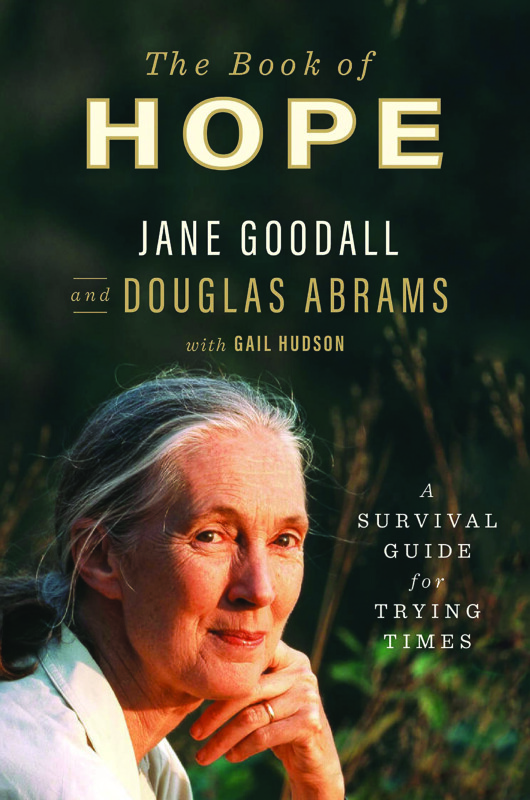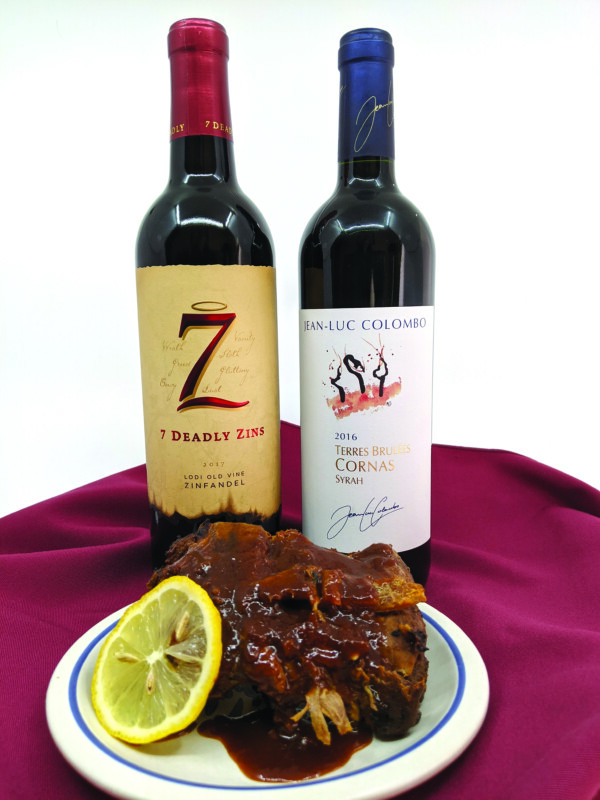The Book of Hope, A Survival Guide for Trying Times, by Jane Goodall and Douglas Abrams with Gail Hudson (Celadon, 249 pages)
Jane Goodall was just 23 years old when a renowned paleoanthropologist hired her to study the behavior of chimpanzees in the wild in Tanzania. Goodall had no background in science, not even a college degree.
But she had something that proved even more important: persistence. She was willing to sit for hours patiently and crawl through brush looking for the animals that her boss believed could better explain human evolution. Goodall also had her mother, who accompanied her on the trip and would share a “wee dram” of whiskey with her every night, Goodall writes in her latest venture, The Book of Hope.
Months passed before Goodall had anything to report, but one day she observed a male chimpanzee using a stem of grass to scoop termites out of a mound. This was an exciting development in animal science, since at that time it was believed that only humans used tools. It was also an exciting development for Goodall personally, because she got new funding and began the career that would see her become the world’s most famous naturalist.
Now 87, Goodall is still mostly known for her work with chimpanzees, although these days her primary job is giving talks about environmental issues via Zoom. She is deeply concerned about climate change, extinction, the loss of animal habitat and a host of other connected issues, as is Douglas Abrams, her co-author and the likely reason this promising title disappoints.
Abrams is an entrepreneur and another “New York Times bestselling author” you’ve never heard of. His company, Idea Architects, came up with the idea to do a series of books collaborating with famous people on a cheery topic like hope or joy. Abrams’ first book, called The Book of Joy, Lasting Happiness in a Changing World, was built around the Dalai Lama and Archbishop Desmond Tutu. Goodall, meanwhile, gets the subject of hope all to herself.
It was a good idea, poorly executed. Throughout her career Goodall has been something of an ambassador of hope for the natural world, and she’s written multiple books about her work. She understands what’s known as “eco-grief” — a sense of despair about what’s happening to the planet and its inhabitants. But because of Goodall’s observations of how flora and fauna can recover from devastation, she says there are four reasons that people should be hopeful about the future.
Sure, they are platitudes (cue “the indomitable human spirit” and “the resilience of nature”), but in the right hands this book might have worked. Unfortunately these are the wrong hands, and they’re too many of them. (Who is this “with Gail Hudson” mentioned on the cover and nowhere else?) Generally speaking, the chances a movie will be bad rise in proportion to the number of screenwriters. This is true of books, too.
But I blame Abrams, who employs the laziest form of narration: unspooling conversations in banal “I said, she said” construction while padding paragraphs with unnecessary, fawning detail.
An example: “The morning sun was making Jane’s cheeks glow as we began another day of interviews. Looking at her in her salmon-colored turtleneck and gray, puffy jacket, I realized I never thought of her as being old.”
Get a room, people.
The book is based on a series of conversations that Goodall and Abrams had about hope. They begin by discussing her career and what Abrams calls the science of hope — research on what hope is, and how its presence or absence can inspire or kill us. They also quickly destroy any hope that the book will be compelling by strangely talking about the book within the book.
Actual line: “Okay, we can add a section of Further Reading for those who want to learn more about the research we discuss in the dialogue.”
Goodall is the victim here. When she’s allowed to talk, with no descriptions of what she is wearing or what warm throw she is wrapping around her shoulders by the fireside, she is generally fascinating, as are her stories.
I’d heard before about 2,000-year-old seeds that archaeologists sprouted, but I didn’t know that these were the seeds of date plants collected from the courtyard of the biblical King Herod, nor did I know they grew to mature trees that bore fruit. Goodall herself has eaten one of those dates.
Nor did I know about the Survivor Tree from 9/11, a pear tree that was nearly destroyed when the towers collapsed but was painstakingly nursed back to health, was replanted near Ground Zero, and has since cradled birds’ nests.
These are the sort of stories that Goodall says gives her hope, along with similar stories of animals on the brink of extinction that are coming back with intensive human intervention.
For example, there’s an endangered bird in Europe, the black robin, that naturalists coaxed into laying two eggs, which they took from the nest (with much angst) and placed in another nest to hatch. The hope was that the parents would try again and they did, building another nest and laying two more eggs, which again were removed. Eventually there were six eggs that hatched, and all the fledglings were returned to the mother (with extra food so she wouldn’t exhaust herself trying to feed them.)
She is also inspired by “rewilding” efforts going on in Europe, the intentional return of wolves to national parks in the U.S., and hundreds of other projects that attempt to undo damage to ecosystems by overhunting and overharvesting. And Goodall and Abrams spend a whole chapter drawing hope from the actions of young people.
The book ends with a discussion of Goodall’s hope in life after death. It’s a surprising turn in the conversation born of a question someone asked her once: What’s your next big adventure? Dying, she said, and she wasn’t being morbid. “If there’s something (after death), which I believe, what greater adventure can it be than finding out what it is?”
Abrams may well be a terrific interviewer, and he does extract interesting stories from Goodall, but his prose is uninspired at best, and too often tedious. He did Goodall no favors by injecting himself into what should have been solely her book. C
Book Notes
A debut author who lives in Vermont is getting a lot of buzz on must-read lists for fall.
The novel is The Memoirs of Stockholm Sven (Little, Brown and Co., 336 pages), and the author is Nathaniel Ian Miller, who once wrote for newspapers but now raises beef cattle. Animal-rights activists best stay from the Ned’s Best Beef website, which features pictures of cows with cutlines that say things like “tasted fantastic.”
Let’s hope, at least, he brings that sense of humor to the novel, which is about a Stockholm man who goes to the Arctic seeking adventure and gets more than he bargained for when he is disfigured in an avalanche. “There, with the company of a loyal dog, he builds a hut and lives alone, testing himself against the elements,” according to the publisher. They had me at “the company of a loyal dog,” although I still have not emotionally recovered from the loyal dog in Peter Heller’s The Dog Stars(Vintage, 336 pages).
Another promising new book that will wreck your emotions is One Friday in April, a memoir about suicide by Donald Antrim, who came close to jumping off the roof of his four-story apartment building in 2006. Antrim is a novelist with impressive credentials, including a MacArthur Fellowship and being named one of 20 best novelists under 40 by The New Yorker in 1999. Those accolades could not erase the pain that Antrim battled, which he considers a disease of the body and brain called suicide. The excerpt on Amazon is riveting, whether or not you have intimate knowledge of this disease.
Finally, Mary Roach, queen of the one-word titles (Stiff, Bonk, Gulp, Grunt and Spook, among others) is back with Fuzz (W.W. Norton, 320 pages), subtitled “When nature breaks the law.” Roach is a science writer with a gift for digging up seemingly implausible things, such as the fact that just a few centuries ago animals were actually put on trial for human crimes like trespassing or breaking and entering. (And you thought our legal system had problems now.) It looks like another fun read that will give you plenty to talk about at holiday parties. If there are holiday parties, you know.
Book Events
Author events
• CATHERYNNE M. VALENTE Author presents Comfort Me With Apples. Virtual event hosted by Gibson’s Bookstore. Fri., Oct. 29, 7 p.m. Via Zoom. Registration required. Visit gibsonsbookstore.com.
• MITCH ALBOM Author presents The Stranger in the Lifeboat. Virtual event hosted by Gibson’s Bookstore. Fri., Nov. 5, 7:30 p.m. Via Zoom. Registration required. Visit gibsonsbookstore.com.
• KEN FOLLETT Author presents Never. Virtual event with author discussion and audience Q&A, hosted by The Music Hall in Portsmouth. Sun., Nov. 14, 1 p.m. Tickets cost $36 and include a book for in-person pickup at The Music Hall. Visit themusichall.org or call 436-2400.
Poetry
• “IN MY SHOES” Poetry reading and open mic event. Eight poets who recently completed a four-week poetry class will read their poetry. Community members are invited to bring and read an original or favorite poem that fits with the theme for the open mic portion. Sat., Oct. 30, 1 to 3 p.m. Twiggs Gallery (254 King St., Boscawen). Free. Light refreshments will be served. Visit twiggsgallery.wordpress.com or call 975-0015.
• COVID SPRING II BOOK LAUNCHVirtual book launch celebrating COVID Spring II: More Granite State Pandemic Poems, an anthology of poetry by 51 New Hampshire residents about the pandemic experience in New Hampshire, now available through independent Concord-based publisher Hobblebush Books. Includes an introduction by Mary Russell, Director of the New Hampshire Center for the Book at the New Hampshire State Library. Sun., Nov. 7, 7 p.m. Virtual, via Zoom. Registration required. Visit hobblebush.com or call 715-9615.
Book Clubs
• BOOKERY Online. Monthly. Third Thursday, 6 p.m. Bookstore based in Manchester. Visit bookerymht.com or call 836-6600.
• GIBSON’S BOOKSTORE Online, via Zoom. Monthly. First Monday, 5:30 p.m. Bookstore based in Concord. Visit gibsonsbookstore.com/gibsons-book-club-2020-2021 or call 224-0562.
• GOFFSTOWN PUBLIC LIBRARY 2 High St., Goffstown. Monthly. Third Wednesday, 1:30 p.m. Call 497-2102, email elizabethw@goffstownlibrary.com or visit goffstownlibrary.com
• NASHUA PUBLIC LIBRARY Online. Monthly. Second Friday, 3 p.m. Call 589-4611, email information@nashualibrary.org or visit nashualibrary.org.






